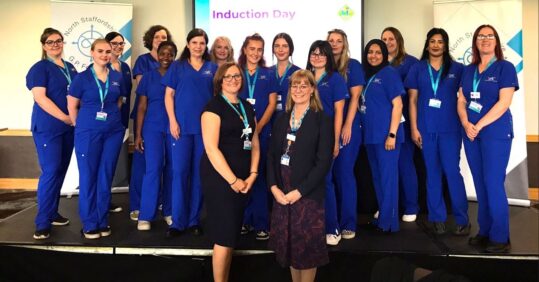Exclusive: New ‘GPN school’ to create a future workforce ‘like no others’

A recently launched training pathway for nurses new to general practice hopes to become a ‘gold standard’ national programme that will help create a future generation of general practice nurses (GPNs) ‘like no others’.
Strategic nurse lead Rachel Viggars and GPN lead and facilitator Gill Boast have spoken exclusively to Nursing in Practice about a new GPN Foundation School in Staffordshire – a project aiming to standardise training and move away from a ‘pick and mix’ of education that many GPNs currently face.
The scheme, launched in September and supported by the Queen’s Nursing Institute (QNI), has 15 recruits in its first cohort, made up of newly registered nurses and those new to general practice.
Those on the programme attend while being employed on a full-time contract for 12 months – some within a primary care network model and some within a GP practice – and typically spend one day a week at university and half a day together as part of a fellowship day, led by Ms Boast. Participants also have 26 hours of clinical time per week.
With a clinical topic of the month, the programme also includes leadership workshops ‘to help them develop their compassionate leadership skills and help them lead some change in primary care’, said Ms Boast.
Related Article: How could future nurses use robots to help deliver care?
The standardised and consistent approach ensures GPNs ‘get the same opportunities, education, that gold standard of an academic qualification within that, but also that support and nurturing and the fellowship and leadership skills that they need to become a fantastic a GPN’, said Ms Viggars, who is also the programme director of the school.
She said practices ‘have to get away from this pick and mix of education’ experienced by GPNs, where some might be unable to complete training courses due to staff shortages and where others are being asked to pay for their own training and to complete it in their own time.
On completion of the programme, while participants may not be ‘a fully-fledged really experienced practice nurse’, they will be able to ‘function safely in general practice with the right standards and the right education behind you’.
‘And you can speak up and say when you need extra training, what your competencies are, and you’re not pushed to be working outside of that competency and outside your NMC Code,’ added Ms Viggars.
The school is to be reviewed and evaluated in the hope it can be rolled out at a national level, something those behind the scheme feel is essential to showcasing the value and importance of the profession.
Ms Boast told Nursing in Practice it was ‘vital’ that this was the model adopted by all practices across the country to ensure a ‘consistent approach’ to general practice nursing.
It was also about being ‘fair to patients’, she said, so that the public is ‘getting comparable care in one practice compared to another’.
Similarly, Ms Viggars said it was about ‘putting value into our nurses and value into primary care and ensuring that we can deliver good patient care’.
By putting value into GPN training and into their wellbeing through this foundation school, Ms Viggars believed there would be a ‘future generation of general practice nurses that will be like no others’.
Related Article: What we do and don’t know about practice nurses being added to ARRS
Key to the success of the programme being rolled out nationally was working to ensure GPNs are seen as the highly skilled professionals they are and as ‘core staff’ in general practice.
‘We’re not additional staff and practices cannot survive without the nursing leadership within their practices,’ added Ms Viggars.
Acknowledging that this was ‘a hard culture to change’, Ms Viggars said she thinks ‘it is doable’.
It felt like a ‘now or never’ moment for this training opportunity for GPNs, she said.
‘This is our opportunity to get this right and to prove this at scale,’ she added.
Ms Viggars said she had once heard that ‘often the problem with general practice nursing recruitment and retention is that it’s on the “too difficult pile”’.
Related Article: GPN pay: A reflection on the last 12 months
‘People know it needs to be done, but it’s just too difficult to sort out,’ she said.
‘But we’ve proved that we can sort it out. We’ve done that already and our system is working.
‘We’ve got buy in, but we just need it to be bigger. So, we need more people to look at it and go, “what they’re doing is the right thing and it’s working, so let’s do this as well”.’

See how our symptom tool can help you make better sense of patient presentations
Click here to search a symptom




